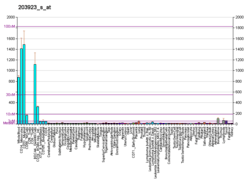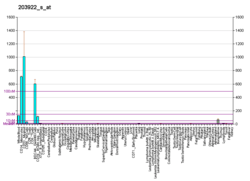NOX2
NADPH oxidase 2 (Nox2), also known as cytochrome b(558) subunit beta or Cytochrome b-245 heavy chain, is a protein that in humans is encoded by the NOX2 gene (also called CYBB gene).[5] The protein is a super-oxide generating enzyme which forms reactive oxygen species (ROS).
Function
Nox2, or Cytochrome b (-245) is composed of cytochrome b alpha (CYBA) and beta (CYBB) chain. It has been proposed as a primary component of the microbicidal oxidase system of phagocytes.[5]
Nox2 is the catalytic, membrane-bound subunit of NADPH oxidase. It is inactive until it binds to the membrane-anchored p22phox, forming the heterodimer known as flavocytochrome b558.[6] After activation, the regulatory subunits p67phox, p47phox, p40phox and a GTPase, typically Rac, are recruited to the complex to form NADPH oxidase on the plasma membrane or phagosomal membrane.[7] Nox2 itself is composed of an N-terminal transmembrane domain that binds two heme groups, and a C-terminal domain that is able to bind to FAD and NADPH.[8]
There has been recent evidence that it plays an important role in atherosclerotic lesion development in the aortic arch, thoracic, and abdominal aorta.[9]
It has also been shown to play a part in determining the size of a myocardial infarction due to its connection to ROS, which play a role in myocardial reperfusion injury. This was a result of the relation between Nox2 and signaling necessary for neutrophil recruitment.[10] Furthermore, it increases global post-reperfusion oxidative stress, likely due to decreased STAT3 and Erk phosphorylation.[10]
In addition, it appears that hippocampal oxidative stress is increased in septic animals due to the actions of Nox2. This connection also came about through the actions of the chemically active ROS, which work as one of the main components that help in the development of neuroinflammation associated with Sepsis-associated encephalopathy (SAE).[11]
Lastly, due to recent experiments, it seems that Nox2 also plays an important role in angiotensin II-mediated inward remodelling in cerebral arterioles due to the emittance of superoxides from Nox2-containing NADPH oxidases.[12]
Clinical significance
CYBB deficiency is one of five described biochemical defects associated with chronic granulomatous disease (CGD). CGD is characterized by recurrent, severe infections to pathogens that are normally harmless to humans, such as the common mold Aspergillus niger, and can result from point mutations in the gene encoding Nox2. [8] In this disorder, there is decreased activity of phagocyte NADPH oxidase; neutrophils are able to phagocytize bacteria but cannot kill them in the phagocytic vacuoles. The cause of the killing defect is an inability to increase the cell's respiration and consequent failure to deliver activated oxygen into the phagocytic vacuole.[5]
Since Nox2 was shown to play a huge part in determining the size of a myocardial infarction, this transforms the protein into a possible future target through drug medication due to its negative effect on myocardial reperfusion.[10]
Recent evidence highly suggests that Nox2 generates ROS which contribute to reduce flow-mediated dilation (FMD) in patients with periphery artery disease (PAD). Scientists have gone to conclude that administering an antioxidant helps with inhibiting Nox2 activity and allowing in the improvement of arterial dilation.[13]
Lastly, targeting Nox2 in the bone marrow could be a great therapeutic attempt at treating vascular injury during diabetic retinopathy (damage to the retina), because the Nox2-generated ROS which are produced by the bone-marrow derived cells & local retinal cells are accumulating the vascular injury in the diabetic retina area.[14]
Interactions
Nox2 has been shown to interact directly with podocyte TRPC6 channels.[15]
References
- 1 2 3 GRCh38: Ensembl release 89: ENSG00000165168 - Ensembl, May 2017
- 1 2 3 GRCm38: Ensembl release 89: ENSMUSG00000015340 - Ensembl, May 2017
- ↑ "Human PubMed Reference:".
- ↑ "Mouse PubMed Reference:".
- 1 2 3 "Entrez Gene: CYBB cytochrome b-245, beta polypeptide (chronic granulomatous disease)".
- ↑ Hervé C, Tonon T, Collén J, Corre E, Boyen C (March 2006). "NADPH oxidases in Eukaryotes: red algae provide new hints!". Current Genetics. 49 (3): 190–204. doi:10.1007/s00294-005-0044-z. PMID 16344959.
- ↑ Kawahara T, Lambeth JD (September 2007). "Molecular evolution of Phox-related regulatory subunits for NADPH oxidase enzymes". BMC Evolutionary Biology. 7: 178. doi:10.1186/1471-2148-7-178. PMC 2121648. PMID 17900370.
- 1 2 Aguirre, Jesús; Lambeth, J (2010). "Nox enzymes from fungus to fly to fish and what they tell us about Nox function in mammals". Free Radical Biology and Medicine. 49 (9): 1342–1353. doi:10.1016/j.freeradbiomed.2010.07.027. PMC 2981133. PMID 20696238.
- ↑ Chaubey, S; Jones, G. E; Shah, A. M; Cave, A. C; Wells, C. M (2013). "Nox2 is required for macrophage chemotaxis towards CSF-1". PLOS ONE. 8 (2): e54869. doi:10.1371/journal.pone.0054869. PMC 3562318. PMID 23383302.
- 1 2 3 Braunersreuther V, Montecucco F, Asrih M, Ashri M, Pelli G, Galan K, Frias M, Burger F, Quinderé AL, Montessuit C, Krause KH, Mach F, Jaquet V (November 2013). "Role of NADPH oxidase isoforms NOX1, NOX2 and NOX4 in myocardial ischemia/reperfusion injury". Journal of Molecular and Cellular Cardiology. 64: 99–107. doi:10.1016/j.yjmcc.2013.09.007. PMID 24051369.
- ↑ Hernandes MS, D'Avila JC, Trevelin SC, Reis PA, Kinjo ER, Lopes LR, Castro-Faria-Neto HC, Cunha FQ, Britto LR, Bozza FA (February 2014). "The role of Nox2-derived ROS in the development of cognitive impairment after sepsis". Journal of Neuroinflammation. 11 (1): 36. doi:10.1186/1742-2094-11-36. PMC 3974031. PMID 24571599.
- ↑ Chan SL, Baumbach GL (26 June 2013). "Deficiency of Nox2 prevents angiotensin II-induced inward remodeling in cerebral arterioles". Frontiers in Physiology. 4: 133. doi:10.3389/fphys.2013.00133. PMC 3693079. PMID 23805104.
- ↑ Loffredo L, Carnevale R, Cangemi R, Angelico F, Augelletti T, Di Santo S, Calabrese CM, Della Volpe L, Pignatelli P, Perri L, Basili S, Violi F (April 2013). "NOX2 up-regulation is associated with artery dysfunction in patients with peripheral artery disease". International Journal of Cardiology. 165 (1): 184–92. doi:10.1016/j.ijcard.2012.01.069. PMID 22336250.
- ↑ Rojas, Modesto; Zhang, Wenbo; Xu, Zhimin; Lemtalsi, Tahira; Chandler, Phillip; Toque, Haroldo A; Caldwell, Robert W; Caldwell, Ruth B (2013). "Requirement of NOX2 Expression in Both Retina and Bone Marrow for Diabetes-Induced Retinal Vascular Injury". PLOS ONE. 8 (12): e84357. doi:10.1371/journal.pone.0084357. PMC 3866146. PMID 24358357.
- ↑ Kim EY, Anderson M, Wilson C, Hagmann H, Benzing T, Dryer SE (November 2013). "NOX2 interacts with podocyte TRPC6 channels and contributes to their activation by diacylglycerol: essential role of podocin in formation of this complex". American Journal of Physiology. Cell Physiology. 305 (9): C960–71. doi:10.1152/ajpcell.00191.2013. PMID 23948707.
Further reading
- Bolscher BG, de Boer M, de Klein A, Weening RS, Roos D (June 1991). "Point mutations in the beta-subunit of cytochrome b558 leading to X-linked chronic granulomatous disease". Blood. 77 (11): 2482–7. PMID 1710153.
- Nong Y, Kandil O, Tobin EH, Rose RM, Remold HG (January 1991). "The HIV core protein p24 inhibits interferon-gamma-induced increase of HLA-DR and cytochrome b heavy chain mRNA levels in the human monocyte-like cell line THP1". Cellular Immunology. 132 (1): 10–6. doi:10.1016/0008-8749(91)90002-S. PMID 1905983.
- Dinauer MC, Pierce EA, Bruns GA, Curnutte JT, Orkin SH (November 1990). "Human neutrophil cytochrome b light chain (p22-phox). Gene structure, chromosomal location, and mutations in cytochrome-negative autosomal recessive chronic granulomatous disease". The Journal of Clinical Investigation. 86 (5): 1729–37. doi:10.1172/JCI114898. PMC 296926. PMID 2243141.
- Royer-Pokora B, Kunkel LM, Monaco AP, Goff SC, Newburger PE, Baehner RL, Cole FS, Curnutte JT, Orkin SH (1986). "Cloning the gene for an inherited human disorder--chronic granulomatous disease--on the basis of its chromosomal location". Nature. 322 (6074): 32–8. doi:10.1038/322032a0. PMID 2425263.
- Dinauer MC, Curnutte JT, Rosen H, Orkin SH (December 1989). "A missense mutation in the neutrophil cytochrome b heavy chain in cytochrome-positive X-linked chronic granulomatous disease". The Journal of Clinical Investigation. 84 (6): 2012–6. doi:10.1172/JCI114393. PMC 304086. PMID 2556453.
- Dinauer MC, Orkin SH, Brown R, Jesaitis AJ, Parkos CA (1987). "The glycoprotein encoded by the X-linked chronic granulomatous disease locus is a component of the neutrophil cytochrome b complex". Nature. 327 (6124): 717–20. doi:10.1038/327717a0. PMID 3600768.
- Teahan C, Rowe P, Parker P, Totty N, Segal AW (1987). "The X-linked chronic granulomatous disease gene codes for the beta-chain of cytochrome b-245". Nature. 327 (6124): 720–1. doi:10.1038/327720a0. PMID 3600769.
- Rabbani H, de Boer M, Ahlin A, Sundin U, Elinder G, Hammarström L, Palmblad J, Smith CI, Roos D (October 1993). "A 40-base-pair duplication in the gp91-phox gene leading to X-linked chronic granulomatous disease". European Journal of Haematology. 51 (4): 218–22. doi:10.1111/j.1600-0609.1993.tb00634.x. PMID 7694872.
- Pollock JD, Williams DA, Gifford MA, Li LL, Du X, Fisherman J, Orkin SH, Doerschuk CM, Dinauer MC (February 1995). "Mouse model of X-linked chronic granulomatous disease, an inherited defect in phagocyte superoxide production". Nature Genetics. 9 (2): 202–9. doi:10.1038/ng0295-202. PMID 7719350.
- Ariga T, Sakiyama Y, Matsumoto S (October 1994). "Two novel point mutations in the cytochrome b 558 heavy chain gene, detected in two Japanese patients with X-linked chronic granulomatous disease". Human Genetics. 94 (4): 441. doi:10.1007/BF00201609. PMID 7927345.
- Leto TL, Adams AG, de Mendez I (October 1994). "Assembly of the phagocyte NADPH oxidase: binding of Src homology 3 domains to proline-rich targets". Proceedings of the National Academy of Sciences of the United States of America. 91 (22): 10650–4. doi:10.1073/pnas.91.22.10650. PMC 45079. PMID 7938008.
- Ariga T, Sakiyama Y, Tomizawa K, Imajoh-Ohmi S, Kanegasaki S, Matsumoto S (June 1993). "A newly recognized point mutation in the cytochrome b558 heavy chain gene replacing alanine57 by glutamic acid, in a patient with cytochrome b positive X-linked chronic granulomatous disease". European Journal of Pediatrics. 152 (6): 469–72. doi:10.1007/BF01955051. PMID 8101486.
- Leusen JH, de Boer M, Bolscher BG, Hilarius PM, Weening RS, Ochs HD, Roos D, Verhoeven AJ (May 1994). "A point mutation in gp91-phox of cytochrome b558 of the human NADPH oxidase leading to defective translocation of the cytosolic proteins p47-phox and p67-phox". The Journal of Clinical Investigation. 93 (5): 2120–6. doi:10.1172/JCI117207. PMC 294341. PMID 8182143.
- Meindl A, Carvalho MR, Herrmann K, Lorenz B, Achatz H, Lorenz B, Apfelstedt-Sylla E, Wittwer B, Ross M, Meitinger T (December 1995). "A gene (SRPX) encoding a sushi-repeat-containing protein is deleted in patients with X-linked retinitis pigmentosa". Human Molecular Genetics. 4 (12): 2339–46. doi:10.1093/hmg/4.12.2339. PMID 8634708.
- Sathyamoorthy M, de Mendez I, Adams AG, Leto TL (April 1997). "p40(phox) down-regulates NADPH oxidase activity through interactions with its SH3 domain". The Journal of Biological Chemistry. 272 (14): 9141–6. doi:10.1074/jbc.272.14.9141. PMID 9083043.
- Eklund EA, Kakar R (April 1997). "Identification and characterization of TF1(phox), a DNA-binding protein that increases expression of gp91(phox) in PLB985 myeloid leukemia cells". The Journal of Biological Chemistry. 272 (14): 9344–55. doi:10.1074/jbc.272.14.9344. PMID 9083071.
- Jendrossek V, Ritzel A, Neubauer B, Heyden S, Gahr M (February 1997). "An in-frame triplet deletion within the gp91-phox gene in an adult X-linked chronic granulomatous disease patient with residual NADPH-oxidase activity". European Journal of Haematology. 58 (2): 78–85. doi:10.1111/j.1600-0609.1997.tb00928.x. PMID 9111587.
- Rae J, Newburger PE, Dinauer MC, Noack D, Hopkins PJ, Kuruto R, Curnutte JT (June 1998). "X-Linked chronic granulomatous disease: mutations in the CYBB gene encoding the gp91-phox component of respiratory-burst oxidase". American Journal of Human Genetics. 62 (6): 1320–31. doi:10.1086/301874. PMC 1377153. PMID 9585602.
- Ariga T, Furuta H, Cho K, Sakiyama Y (July 1998). "Genetic analysis of 13 families with X-linked chronic granulomatous disease reveals a low proportion of sporadic patients and a high proportion of sporadic carriers". Pediatric Research. 44 (1): 85–92. doi:10.1203/00006450-199807000-00014. PMID 9667376.
- Kumatori A, Faizunnessa NN, Suzuki S, Moriuchi T, Kurozumi H, Nakamura M (October 1998). "Nonhomologous recombination between the cytochrome b558 heavy chain gene (CYBB) and LINE-1 causes an X-linked chronic granulomatous disease". Genomics. 53 (2): 123–8. doi:10.1006/geno.1998.5510. PMID 9790760.
External links
- gp91phox+protein,+human at the US National Library of Medicine Medical Subject Headings (MeSH)
- Human CYBB genome location and CYBB gene details page in the UCSC Genome Browser.





